
Haankhef was the father of the ancient Egyptian kings Neferhotep I, Sihathor, and Sobekhotep IV, who successively ruled Egypt during the second half of the 18th century BC as kings of the 13th Dynasty.

Haankhef was the father of the ancient Egyptian kings Neferhotep I, Sihathor, and Sobekhotep IV, who successively ruled Egypt during the second half of the 18th century BC as kings of the 13th Dynasty.
Haankhef is known from a number of monuments all of which are connected to his royal sons. On his monuments Haankhef bears the titles "Royal Sealer" and "God's Father". Both titles were given to him after his sons became kings and it is consequently unknown what position he held before these events. "God's father" is a title often given to the non-royal parents of a king and Haankhef's father Nehy is indeed known to have been a simple "officer of the town regiment" in Thebes. Similarly Haankhef's mother Senebtysy only held the common title of "Lady of the House". This indicates that Haankhef belonged to a rather middle level family of military officials. [2] What role this background played in the accession of Neferhotep I to the throne is unknown. Haankhef is one of only two fathers of a pharaoh to be mentioned on the Turin canon, a king list redacted during the early Ramesside era. The reason for this rare privilege is uncertain, it may be connected to his two royal sons who were later considered as the greatest kings of the 13th Dynasty in an otherwise shaky period for Egypt.
The wife of Haankhef is known to have been named Kemi thanks to several sources, in particular rock inscriptions made by Neferhotep I on Sehel Island, Konosso and Philae. In these inscriptions, Kemi is often named together with Haankhef although there are also a number of scaraboid seals naming her and her son without any mention of Haankhef. A stela of Neferhotep I from Abydos indicates that she was already dead by the second regnal year of her eldest son. Haankhef grandson by Neferhotep I was also named Haankhef, possibly in his honour.
| Nehy | Senebtisi | ||||||||||||||||||||||||||||||||||||||||||||||||||
| Haankhef | Kemi | ||||||||||||||||||||||||||||||||||||||||||||||||||
| | | | |||||||||||||||||||||||||||||||||||||||||||||||||
Haankhef (PD 410) is known from several items. [3]
Block Rio de Janeiro 637/638 [2428] provides the name of his parents. [4] At Elephantine, a statue Aswan 1347 belonging to King's Son Sihathor (brother of King Neferhotep I) refers to the King's Mother Kemi and God's Father Haaankhef. [5]
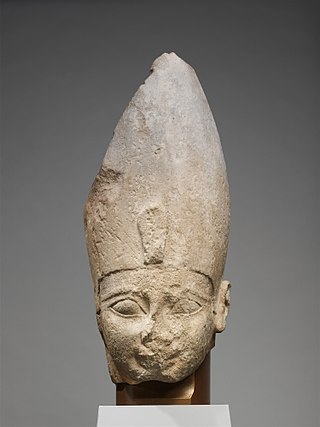
Ahmose I was a pharaoh and founder of the Eighteenth Dynasty of Egypt in the New Kingdom of Egypt, the era in which ancient Egypt achieved the peak of its power. His reign is usually dated to the mid-16th century BC at the beginning of the Late Bronze Age.

Khasekhemre Neferhotep I was an Egyptian pharaoh of the mid Thirteenth Dynasty ruling in the second half of the 18th century BC during a time referred to as the late Middle Kingdom or early Second Intermediate Period, depending on the scholar. One of the best attested rulers of the 13th Dynasty, Neferhotep I reigned for 11 years according to the Turin King List.

Khaneferre Sobekhotep IV was one of the more powerful Egyptian kings of the 13th Dynasty, who reigned at least eight years. His brothers, Neferhotep I and Sihathor, were his predecessors on the throne, the latter having only ruled as coregent for a few months.

Merhotepre Sobekhotep was an Egyptian king of the late 13th Dynasty during the Second Intermediate Period.

Wahibre Ibiau was an ancient Egyptian pharaoh of the 13th Dynasty during the Second Intermediate Period, who reigned for 10 years 8 months and 29 days according to the Turin King List.

Sekhemre Sewadjtawy Sobekhotep III was an Egyptian king of the mid Thirteenth Dynasty of Egypt who reigned three to four years.
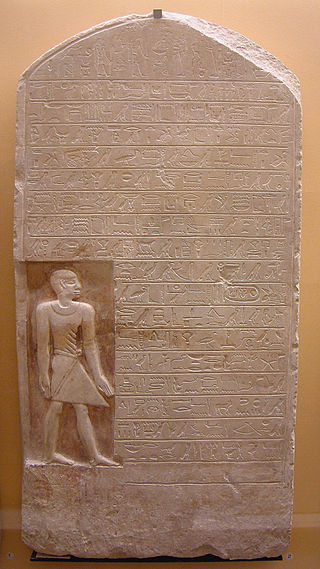
Ankhu was an Egyptian vizier during the early 13th Dynasty in the late Middle Kingdom. He is believed to have resided in Thebes in Upper Egypt.
Ahmose-Nebetta was an Egyptian princess during the late Seventeenth Dynasty of Egypt in the late Second Intermediate Period. She was probably the daughter of Seqenenre Tao and Queen Ahhotep I. She was the sister of Pharaoh Ahmose I of who was the founder of the Eighteenth Dynasty.

Iymeru Neferkare was the ancient Egyptian vizier under king Sobekhotep IV in the 13th Dynasty, in the Second Intermediate Period.

Senebi was an ancient Egyptian treasurer under the late 13th Dynasty kings Neferhotep I and Sobekhotep IV. Senebi belongs to the best attested officials of the 13th Dynasty.
The Papyrus Boulaq 18 is an ancient Egyptian administrative document. It contains an account of the Theban palace dating to the 13th Dynasty. The papyrus lists the palace officials and the rations they received day by day. Important officials mentioned are, for example, the vizier Ankhu, but also the queen Aya. Therefore, the document is of great historical importance. It also reports the journey of the king to the temple at Medamud and reports the arrival of a delegation of Nubians.
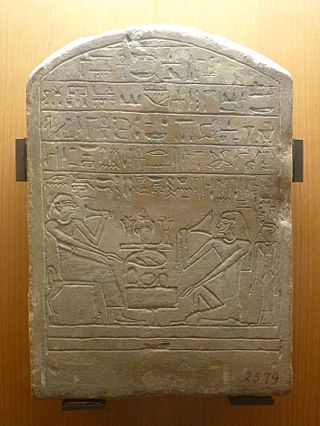
Senewosret-Ankh {s-n-wsrt-ꜥnḫ/snfrw} was an ancient Egyptian vizier of the Middle Kingdom, dating to the end of the Twelfth or to the beginning of the Thirteenth Dynasty.
Nubemhat was an ancient Egyptian queen of the Second Intermediate Period.
Minemhat was an Ancient Egyptian mayor of Koptos during the 17th Dynasty in the late Second Intermediate Period. Minemhat appears in three sources and served during the reign of Nubkheperre Intef.
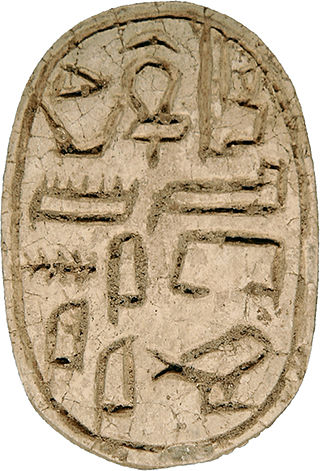
Ameny was an ancient Egyptian official of the 13th Dynasty with the title high steward. In this function he was the main administrator of the royal estates.

Menwadjre Sihathor was an ephemeral ruler of the late 13th Dynasty during the Middle Kingdom. Sihathor may never have enjoyed an independent reign, possibly only ruling for a few months as a coregent with his brother Neferhotep I.
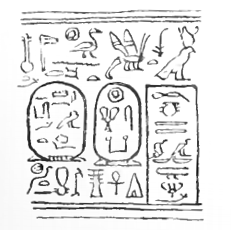
Sekhemkare Amenemhat Senebef was an Egyptian pharaoh of the early 13th Dynasty, often considered as the final part of the late Middle Kingdom or early Second Intermediate Period.
Sobeknakht I was an ancient Egyptian official of the Second Intermediate Period. He was the local governor at Elkab.
Senebsen was an Ancient Egyptian queen and wife of king Neferhotep I during the 13th Dynasty.
Khenmes was an Egyptian vizier during the early 13th Dynasty, in the late Middle Kingdom. One monument associate him with king Sekhemkare. He is believed to have resided in Itjtawy in Lower Egypt.